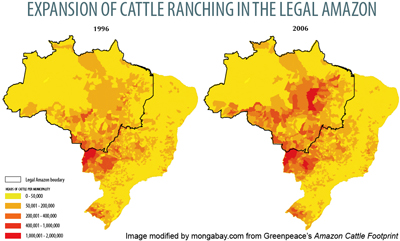An interview with Roberto Smeraldi, founder and director of Amigos da Terra – Amazônia Brasileira.
One of the loudest voices calling for reduction of forest clearing in the Brazilian Amazon is Amigos da Terra – Amazônia Brasileira. Independent from Friends of the Earth International, an activist network, since 2008, Brazil-based Amigos da Terra – Amazônia Brasileira (“Amigos da Terra”) has been at the forefront of raising awareness of environmental concerns among Brazilians, who have historically viewed foreign-led campaigns with suspicion, if not outright contempt.
But reining in deforestation will not be easy. Even if many Brazilian support, in principle, the idea of preserving the Amazon, there are strong economic incentives and political interest in turning the region into a powerhouse of extraction-based industries. Already tens of billions of dollars are flowing into the region to develop infrastructure that will facilitate the rapid expansion of logging, mining, drilling, and large-scale agriculture across substantial swathes of the Amazon. The trend is exemplified by the cattle industry, which has been for years the beneficiary of generous state subsidies in the form of low-interest loans (especially for big cattle processors) and road development projects. As a consequence, cattle ranching is the biggest driver of Amazon deforestation — the fate of 80 percent of cleared land is to become cattle pasture — and a significant source of Brazil’s greenhouse gas emissions. While much of this activity in the past was a vehicle for land speculation or to establish property rights, Amazon cattle ranching has become a multibillion dollar business, supplying much of the world with beef and leather products. Thus in targeting the Amazon cattle industry, environmentalists are taking on a surging behemoth.
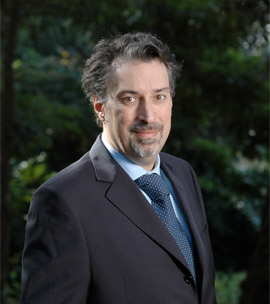
|
But even a behemoth has its weaknesses. In recent months the Brazilian cattle industry has been under fire after environmental groups, including Greenpeace and Amigos da Terra, linked its customers — some of the world’s best known and most exclusive brands — to large-scale destruction of the Amazon rainforest. The revelations had an immediate impact: the Brazilian government launched an investigation and called for sanctions, corporate buyers turned away from questionable Amazon cattle products, and industry financiers re-evaluated their lending practices. The Brazilian cattle industry is now looking for a path forward.
Perhaps unexpectedly for a group with roots in confrontational activism, Amigos da Terra is calling for a rather pragmatic approach to address to the “cattle crisis”. The solution, says Roberto Smeraldi, founder and director of Amigos da Terra, involves improving the productivity of cattle ranching, thereby allowing forest to recover without sacrificing jobs or income; establishing a moratorium on new clearing; and recognizing the economic values of maintaining the ecological functions of Earth’s largest rainforest. Amigos da Terra, together with a broad range of stakeholders including the Brazilian government, industry bodies, major buyers, and other NGOs like Aliança de Terra and Friends of the Earth Sweden, is hammering out criteria to help meet the first two of these objectives through a certification system, which, he hopes, will be complemented with sound public policy. On the third point, Smeraldi envisions the emergence of a “forest economy” based on the knowledge of indigenous forest dwellers, cutting-edge science, and compensation for the ecosystem services provided by the Amazon as a living entity.
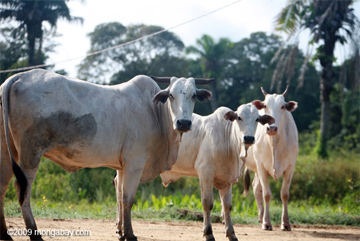 Cattle herd in the Brazilian Amazon. Photo by Rhett A. Butler. |
While the transition will be challenging, Smeraldi believes it offers new opportunities for Brazil to pursue a sustainable development path. For example, Smeraldi notes that cattle ranching presently accounts for roughly a third of Brazil’s greenhouse gas emissions while generating only about 1 percent of national GDP.
“This is a big opportunity for a cost-efficient carbon strategy, which is in the best interest of Brazil and the whole world,” he told mongabay.com during an interview conducted shortly after a National Wildlife Federation-sponsored meeting on cattle certification in Brazil.
INTERVIEW WITH ROBERT SMERALDI
What led you to become a campaigner on behalf of the Amazon?
As a journalist in the early ’80s I covered wars and guerrilla movements around the world. Through my reporting I began to become interested forest conversion. I got in touch with people such as Norman Myers, Catherine Caufield, Jonathon Porritt, Charles Secrett, and Chico Mendes who from different perspectives made me understand how critical forests are. I ended up becoming involved and engaged.
What is Amigos da Terra’s approach to protecting the Amazon?
Our approach to protecting the Amazon is to put people first. This means focusing on regional development as a key condition for effective and sustainable conservation, generating jobs and revenues in the local context rather than just extracting resources (be it cattle, timber, mining or biodiversity), and targeting consumption patterns with a forest footprint in the rest of brazil and abroad.
What does Amigos da Terra – Amazônia Brasileira see as the path forward for cattle in the Amazon?
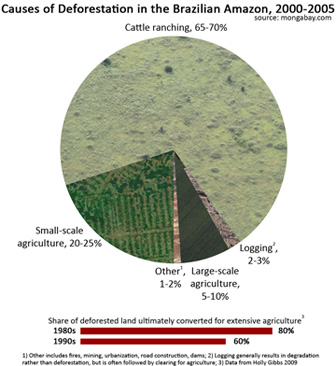
|
A technological revolution in terms of productivity, associated with a drastic reduction in spatial footprint or extensiveness of ranching, a moratorium on expansion of processing capacity and restoration of forests in the area to be abandoned. The latter can help finance the earlier, through carbon credits in the existing market. The objective is moving from 1 head of cattle per hectare to 3 head per hectare, thereby reducing the pasture area by two-thirds, down to about 25 million hectares from the current 74 million. This would also create some 200,000 jobs in the ranching sector (associated with more intensive production), while improving the quality of beef and leather, as well as maintaining the current level of employment in the slaughterhouse sector and the current herd.
What is needed to ensure that a certification system credible? What are your chief concerns with such a system?
In order to be credible, it must be independent (third-party audits), be based on tripartite governance (social, economic and environmental constituencies with equal share), voluntary (no official stamps leading to corruption) and performance-based criteria (not just process-based). Brazil is very close to creating a system of this kind. We are in the final consultation phase of a 3-year long negotiation involving all different stakeholders: it is called the Brazilian Initiative for Agricultural and Livestock Verification. The system can provide a model for other countries and the final version of criteria is to be adopted by the end of October. It will also have a baseline date for zero deforestation. But we should never consider certification as the ONLY solution, otherwise we will end up frustrated. Certification helps in guiding the market, but it still can co-exist with much lower standards. So, certification is necessary but not sufficient, certainly not a panacea or even a substitute for sound public policy. For instance, it cannot effectively respond to what we call “leakage”, or indirect land use change (ILUC), i.e. phenomena that occur at landscape level, rather than at production unit level.
Are you looking at the “carbon relevance” of cattle ranching?
We are in the process of doing an accurate study on lifecycle emissions of Amazon beef (including forest conversion, fire, enteric fermentation, transportation, etc.). We are working with well-respected researchers from government and non-government research centers in Brazil (INPE, EMBRAPA, universities, etc.) and expect the study to be ready by mid-November in time for the climate meeting in Copenhagen. Ranching in the Amazon is a huge source of emissions, in the range of at least one third of Brazilian emissions (and we are the third or fourth largest emitting country, depending on methodologies used to this end). But this represents about 1% of GDP, so this is a big opportunity for a cost-efficient carbon strategy, which is in the best interest of Brazil and the whole world.
Does Amigos da Terra support payments to landowners, including ranchers and farmers, for preserving forest cover on their land?
Who should support this (or not) is the market. We advocate for measures that would actually stimulate markets to value forest services, like caps on emissions and many others. And this would likely lead to the development of trade in allowances. It is a mistake to focus on the payment, which is a consequence. But often discussion starts from the end, and this creates lots of misconceptions and “religious wars”. Once carbon becomes a “fictional good” (as Karl Polanyi used to define land, labour and money), there is little point in excluding one type of carbon from markets, regardless of where it is stored or emitted.
Friends of the Earth International has taken a strong stance against market-based schemes to compensate countries and landowners for protecting forests. What is your position?
Yes, FOEI had a more balanced approach until mid-2007, when it was in favor of a variety of instruments to reduce deforestation. Then, before the COP in Bali, an ideological, anti-market stand was adopted and the network became rather isolated, they even left the Climate Action Network and possibly lost a bit of touch with the concrete aspects of discussion and crucial constituencies, such as forest dwellers. Rather than being a healthy critical voice on any existing proposal, they ended up de facto supporting just official funds, and this is obviously insufficient in the current context. But they still have many brilliant people and I trust they will soon find a new role.
Friends of the Earth – Brazilian Amazonia has been a fully independent organization (separate from FOEI) since March, 2008. We were part of FOEI from 1989 until 2008. We continue to have projects and joint activities with many member groups.
Is Amigos da Terra – Amazônia Brasileira optimistic that Brazil can meet its deforestation reductions targets in the face of increased spending on infrastructure and development under PAC?
The current official deforestation targets are indeed rather modest, but the significant public spending on perverse incentives, which should not be confused with “development”, might make difficult even to attain those over the coming years. So far, we have no sustainable mechanism to reduce deforestation in place.
Does Brazil’s target for reducing deforestation by roughly 70 percent from the 1996-2005 baseline go far enough?
It reminds me of our recent economic past. In 1991, in a scenario of economic recession, our hyperinflation went down to 480%, compared to 1,782% in 1990. At that time we had a minister of economy, Marcílio Moreira, who said this was a big achievement. Of course, nobody was in control of inflation, until 1995, when we finally created a structural system that would radically change the system of perverse financial incentives where inflation was rooted.
What will it take to bring the Brazilian public to support a zero deforestation target?
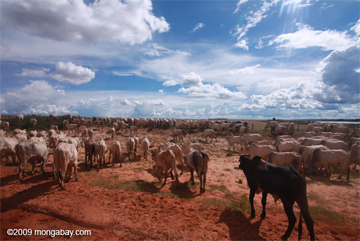 Cattle herd in the Brazilian Amazon. Photos by Rhett A. Butler. |
According to Datafolha, a lead poll agency which conducted a survey with 2% margin of error in April, 2009, 92% of Brazilians already support zero deforestation, even when asked about a trade-off between deforestation and agricultural production. But the lobbies behind activities that drive deforestation are still strong, especially as far as industrial appropriation of public land.
Are you optimistic that the tide in the Amazon can be turned to create sustainable livelihoods while maintaining the ecological integrity of the region?
I am not so optimistic, since we have perverse incentives, but yes, it would be relatively easy to turn it. This because creating decent jobs for the local population would not require much of an investment, given the limited size of it (20 million people in a region as large as continental Europe). You would need to prioritize development rather than a neocolonial approach based on extraction of resources (energy, agricultural commodities, minerals, etc.) that do not create a virtuous circle of jobs, income, savings and investment within the region, i.e. a regional economy. I used to say that the best conservation policy in the Amazon is to develop industry, as opposed to primary production. A forest economy is based on the knowledge of traditional forest dwellers, but associated to advanced science, technology and innovation. I know the Amazon, and I am convinced that it can do this better than any other place on Earth.
